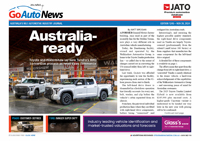Make / Model Search
News - Mercedes-BenzMercedes exercises exclusivityVolume seller: New C-class should become Australia's most popular Benz. Despite record sales volumes, Mercedes retains brand image through selective exports24 Sep 2007 DAIMLER has remained adamant that record annual global sales are not big enough to hurt the exclusivity of its Mercedes-Benz brand. However, as volumes reach the 1.5 million-unit mark, Daimler says it will remain mindful of how elastic the Mercedes-Benz image is, especially in markets where buyers do not want to see the three-pointed star on smaller cars. “Compared to the big players in the world, we are always a luxury car producer and we still have a relatively small market share compared to the big mass-production manufacturers,” says Dr Klaus Maier, executive vice-president of Mercedes Car Group sales and marketing. “I think that will not change over time,” he believes. “If you sell 1.5 million compared to a (smaller amount) it doesn’t matter because it differs (anyway) from country to country. “In Germany we are number two (behind Volkswagen) and still we are seen as a premium brand,” Dr Maier stated. He pointed out that Mercedes has the same premium image in the United States, even though its market share over there is a fraction of Germany’s. “In the US we are seen as a real luxury brand and we have a relatively small market share compared to the US manufacturers or the Japanese. “And therefore I see that this will remain whether we have 10 per cent growth or not. It will remain as the leading brand in the luxury segment. “I don’t believe that the growth from the mid-1990s to now has changed that significantly.  Left: A-class and B-class (below). Left: A-class and B-class (below).Dr Maier says that – in the US at least – consumers are not exposed to the more mass-market Mercedes-Benz vehicles that Europe and Australia see. He said it is critical that Mercedes remains selective with the models that it brings into certain regions, since consumers – especially more conservative buyers – may not warm as readily to a brand that encompasses a wider range of disparate vehicles. “We still have the same product line-up in the US that we had (in the 1990s)... C-class excepted. “The A and B-class are not in the US for instance, so we have clearly looked at the markets where we could go further down in the portfolio or not.” With both these models having been on sale in Australia for a number of years now, Mercedes sees this market as strong enough to differentiate its ‘prestige’ small cars from its ‘luxury’ large vehicles. “Obviously yes, because that is where we have put the products in place,” Dr Maier responded. He was also quick to point out that its current – and at times maligned – front-wheel drive small-car range is as valid and true a Mercedes-Benz product as the larger rear-wheel drive models such as the C, E and S-class vehicles. “I would not say that the A and B are not premium cars in their segments. “(It is just that) some of the countries like China and the US, the strength of the brand is built from the top down... the S and E-class is where Mercedes is positioned. “That’s why we are very careful not to devalue the brand in those countries or regions. “You know, there is no discussion about (devaluing the Mercedes brand) in Germany because there are (Mercedes) vans and trucks and taxis. “So you have to see how the differences in the various regions, and how the Mercedes brand appears in total. “And in Australia we have Mercedes trucks and vans – similar to what we have in Europe – and it is completely different to what we have in the United States.” |
Click to shareMercedes-Benz articlesResearch Mercedes-Benz Motor industry news |









Facebook Twitter Instagram